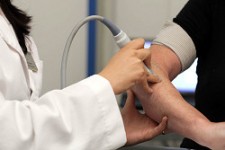Physical Therapists Use Neuro-Ultrasound to Identify and Treat Nerve Pathology

Astoria, NY, May 7, 2017 (Newswire.com) - Ultrasound technology has been used in the Physical Therapy profession for many years. Its most frequent application has been in the realm of treatment and therapy, as ultrasound of a certain frequency can deliver deep heat into the muscles and have a therapeutic effect. Other applications include delivery of medication to the subcutaneous tissues through the ultrasound waves.
Recent advancements in ultrasound technology have allowed health care providers to use high-frequency ultrasound to visualize muscle tissues, tendons, ligaments, nerves, bones and other structures. High-resolution ultrasound has enabled Physical Therapists, and other healthcare providers evaluate the integrity of the neural tissue. The last few years neuro-sonography can be used to identify swellings of the nerve proximal to the sites of compression, as well as changes in echo texture.
Diagnostic Ultrasound technology can help the therapist not only identify the nerve problem but also treat it with the highest possible accuracy and effectiveness
Dimitrios Kostopoulos, PT, DPT, MD, PhD, DSc, ECS
Normal values have been established to measure the cross-sectional area of nerves as well as other ratios that help to distinguish pathological from normal tissue. Swollen nerves tend to be more hypoechoic in echotexture as they lose the honey-comb appearance which is characteristic of neural tissue in cross section. This honey-comb appearance represents visualization of the fascicular pattern of nerves.
Physical Therapists also evaluate neural pathology using electrodiagnostic evaluations. Electroneuromyography helps to identify the location of nerve pathology, but also the type of pathology. Entrapment syndromes may cause displacement of the myelin sheath that surrounds the nerve axons but also damage of the axon itself. Thus, nerve pathology can be classified as demyelinating, axonal or both.
A recent study published in the Journal of Ultrasound in Medicine was able to investigate sonographic findings according to the pathophysiologic type in patients with carpal tunnel syndrome. The researchers from Korea University School of Medicine retrospectively reviewed the records of 80 patients ( 148 hands) with carpal tunnel syndrome. They classified patients into three groups according to electrophysiologic findings: ( l) conduction block and conduction delay; ( 2) axonal degeneration; and (3) mixed.
The study concluded that the cross-sectional area and wrist-to-forearm ratio were associated with the pathophysiologic type of carpal tunnel syndrome, with larger nerve swellings seen in patients with axonal degeneration compared with those with demyelinating lesions. This is a breakthrough as the results of the study enable Physical Therapists and other healthcare providers who use Neuro-ultrasound, to use sonography not only for localization of the nerve lesion but also for precise classification of the type of nerve lesion.
"Once the location and type of lesion are identified, the Physical Therapists may use Neuro-Ultrasound to guide them in the performance of neural mobilization techniques to help restore the normality of the tissue. Diagnostic Ultrasound technology can help the therapist not only identify the nerve problem but also treat it with the highest possible accuracy and effectiveness" said Dr. Dimitrios Kostopoulos who is ABPTS board certified in clinical electrophysiology and the co-founder of Hands-On Diagnostics. Hands-On Diagnostics trains Physical Therapists in a variety of diagnostic tests for the evaluation of the neuromuscular system.
Most insurance companies reimburse Physical Therapists for the use of diagnostic musculoskeletal ultrasound which gains ground very fast within the physical therapy profession. Physical Therapists can visualize in both static and dynamic capacity several pathologies, such as rotator cuff tears, ligamentous laxities and tears, myofascial trigger points, nerve pathology and many others.
Physical Therapists with the proper education in the area of musculoskeletal ultrasound can obtain RMSK certification and recognition as musculoskeletal sonographers through the Alliance for Physician Certification and Advancement. For more information, please visit www.diagnosticsforpt.com
Source: Hands-On Diagnostics